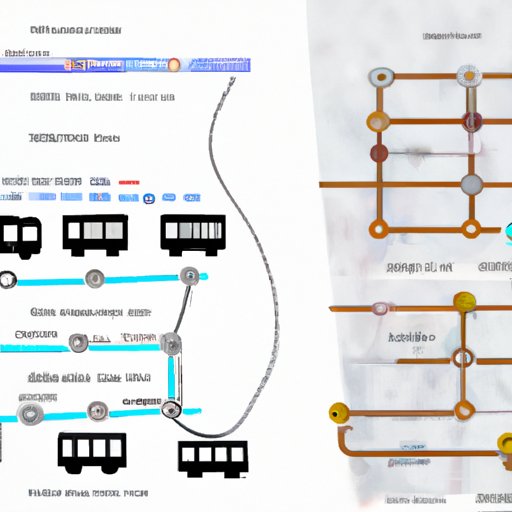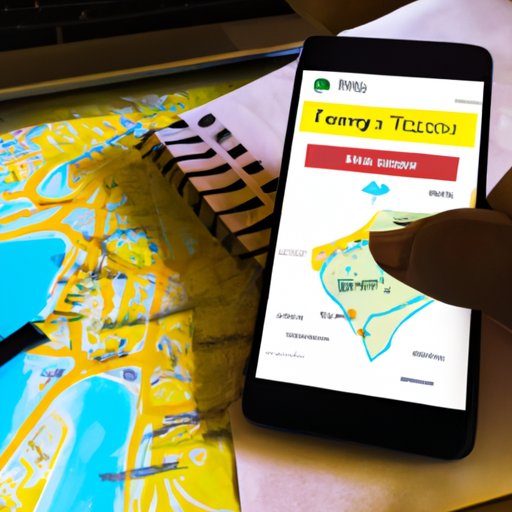Introduction
Travelling can be an exciting and rewarding experience. Whether you’re planning a cross-country road trip or jetting off to an exotic destination, having an itinerary can help you make the most out of your journey. An itinerary is simply a plan of activities and destinations that outlines what you will do during your trip.
Having an itinerary helps you stay organized and allows you to prepare for any potential issues. It also provides structure and allows you to make the most of your time. With proper planning, your itinerary can help ensure that you have a stress-free and enjoyable experience.
Step-by-Step Guide on How to Make an Itinerary for a Trip
Making an itinerary for your trip doesn’t have to be complicated. Here’s a step-by-step guide on how to create an itinerary for your next adventure.
Select a Destination
The first step in creating your itinerary is to select a destination. Think about where you want to go and what type of activities you would like to do while you’re there. Do you want to explore a new city, relax on a beach, or take a cultural tour? Once you’ve settled on a destination, you can begin researching and planning your itinerary.
Estimate the Length of Your Trip
Once you have selected a destination, it’s important to estimate the length of your trip. Consider how much time you have available and decide if you want to take a short weekend trip or a longer vacation. This will help you determine how many days you will need to plan for, as well as how much time you will have at each location.
Research Your Destination
Before you start planning your itinerary, it’s important to research your destination. Read up on local customs, attractions, and activities so you can get an idea of what you’d like to do while you’re there. You can also look into transportation options, such as public transit, rental cars, and taxis. This will help you decide how you want to get around during your trip.
Choose Accommodations
Once you’ve done your research and have a better understanding of your destination, it’s time to choose accommodations. Think about what type of lodging you’d like – a hotel, Airbnb, hostel, or camping site? Consider your budget and preferences when making your decision.
Create Your Itinerary
Now that you’ve chosen your destination and accommodations, it’s time to create your itinerary. Start by making a list of all the places you’d like to visit and activities you’d like to do. Then, map out which days you’ll be doing each activity and where you’ll be staying each night. Finally, add any additional notes or details that you think are important.

Tips and Insight on What to Consider When Making an Itinerary
When making an itinerary, there are several things to consider. Here are some tips and insight on what to think about when planning your trip.
Consider the Type of Trip You are Taking
When making an itinerary, it’s important to consider the type of trip you are taking. Are you planning a sightseeing tour, a beach vacation, or a cultural tour? Each type of trip will require different types of planning and may require more or less time for certain activities.
Set Realistic Goals for Each Day
When creating your itinerary, it’s important to set realistic goals for each day. Don’t try to cram too many activities into one day; instead, spread them out over the course of your trip. This will help ensure that you don’t get overwhelmed or exhausted.
Incorporate Time for Rest and Relaxation
When making an itinerary, it’s important to set aside time for rest and relaxation. Give yourself some breathing room between activities and allow yourself to take breaks throughout the day. This will help you avoid feeling overwhelmed and allow you to really enjoy your trip.
Allow for Flexibility in Your Itinerary
It’s also important to allow for flexibility in your itinerary. Things don’t always go according to plan, so it’s important to leave room for unexpected delays or changes in plans. This will help ensure that you’re not rushed or stressed out during your trip.
Benefits of Having an Itinerary During a Trip
Having an itinerary can provide numerous benefits during your trip. Here are some of the top benefits of having an itinerary.
Helps You Stay Organized
Having an itinerary helps you stay organized and ensures that you don’t miss any important activities or destinations. It also helps you keep track of your plans and makes it easier to remember places and activities you’ve visited or done.
Keeps You On Track of Your Plans
Having an itinerary can help keep you on track of your plans. It gives you a clear timeline of when and where you should be at each point during your trip, which can help prevent you from getting lost or running late.
Makes it Easier to Stick to a Budget
An itinerary can also help you stick to a budget. By planning out your activities ahead of time, you can determine how much money you need for each activity and make sure you stay within your budget.
Allows You to Make the Most of Your Time
Having an itinerary also allows you to make the most of your time. You can plan out your activities in advance and ensure that you’re making the most of every moment of your trip.

Examples of Itineraries from Different Types of Trips
Here are some examples of itineraries from different types of trips.
Sightseeing Tour
Day 1: Arrive in City, Check-in to Hotel, Explore Local Attractions
Day 2: Visit Museums, Take a Walking Tour
Day 3: Visit Historic Sites, Enjoy Local Cuisine
Day 4: Explore Parks and Gardens, Shop at Markets
Day 5: Depart City
Beach Vacation
Day 1: Arrive in Beach Town, Check-in to Hotel, Explore the Beach
Day 2: Go Snorkeling/Diving, Take a Boat Tour
Day 3: Visit Local Restaurants, Relax on the Beach
Day 4: Take a Hike, Enjoy Water Sports
Day 5: Depart Beach Town
Cultural Tour
Day 1: Arrive in City, Check-in to Hotel, Explore Local Culture
Day 2: Visit Cultural Sites, Attend a Festival
Day 3: Taste Local Cuisine, Take a Cooking Class
Day 4: Visit Markets, Go Shopping
Day 5: Depart City
Road Trip
Day 1: Arrive in Starting City, Check-in to Hotel, Explore Local Attractions
Day 2: Drive to Next City, Visit Historic Sites
Day 3: Drive to Next City, Enjoy Local Cuisine
Day 4: Drive to Next City, Explore Parks and Gardens
Day 5: Drive to Final Destination, Check-in to Hotel
Day 6: Depart Final Destination
Ways to Stay Flexible While Following an Itinerary
Even with an itinerary, it’s important to remain flexible during your trip. Here are some ways to stay flexible while following an itinerary.
Leave Room for Spontaneity
When making an itinerary, it’s important to leave room for spontaneity. Allow yourself to explore and take detours along the way. This will help you discover new places and experiences that you may not have considered before.
Prioritize Your Activities
When planning your itinerary, it’s important to prioritize your activities. Determine which activities are most important to you and make sure to fit those into your schedule. This will help you make the most of your time.
Build in Time to Explore
Make sure to build in time to explore when making your itinerary. Leave room for spontaneous activities and unexpected adventures. This will help ensure that you don’t miss out on any hidden gems during your trip.
Have a Backup Plan
Finally, make sure to have a backup plan when making an itinerary. Think about what you would do if something unexpected happens or if you need to change your plans. Having a backup plan can help you stay flexible and prepared for any situation.

How Technology Can Help with Planning an Itinerary
Technology can be a great tool when planning an itinerary. Here are some ways to use technology to make planning your trip easier.
Use Technology to Research
Using technology to research your destination can be helpful when planning an itinerary. The internet is full of resources that can provide information on attractions, activities, and accommodations. Utilizing these resources can help you make informed decisions about your trip.
Utilize Online Itinerary Makers
There are also online itinerary makers that can help you create your itinerary. These tools can help you easily plan out your activities, map out your route, and organize your plans. Many online itinerary makers also allow you to share your itinerary with friends and family.
Leverage Apps to Make Planning Easier
There are also apps available to make planning your itinerary easier. Apps such as TripIt and TripAdvisor can help you manage your bookings and find the best restaurants and attractions near you. These apps can save you time and make planning your trip a breeze.
Take Advantage of Maps and Navigation Tools
Finally, maps and navigation tools can be useful when planning an itinerary. Apps like Google Maps and Waze can help you find the quickest route to your destination and identify traffic patterns. This can help you save time and make sure you arrive at your destination on time.
Conclusion
Creating an itinerary for your trip can help you stay organized and make the most of your time. Planning an itinerary involves selecting a destination, estimating the length of your trip, researching your destination, choosing accommodations, and creating your itinerary. There are also tips and insight on what to consider when making an itinerary, such as setting realistic goals for each day and allowing for flexibility in your itinerary. Additionally, technology can be used to help with planning an itinerary, such as using online itinerary makers and leveraging apps to make planning easier.
Having an itinerary can provide numerous benefits, such as helping you stay organized, keeping you on track of your plans, making it easier to stick to a budget, and allowing you to make the most of your time. By following these steps and tips, you can create an itinerary that will make your trip a memorable and enjoyable experience.
(Note: Is this article not meeting your expectations? Do you have knowledge or insights to share? Unlock new opportunities and expand your reach by joining our authors team. Click Registration to join us and share your expertise with our readers.)
